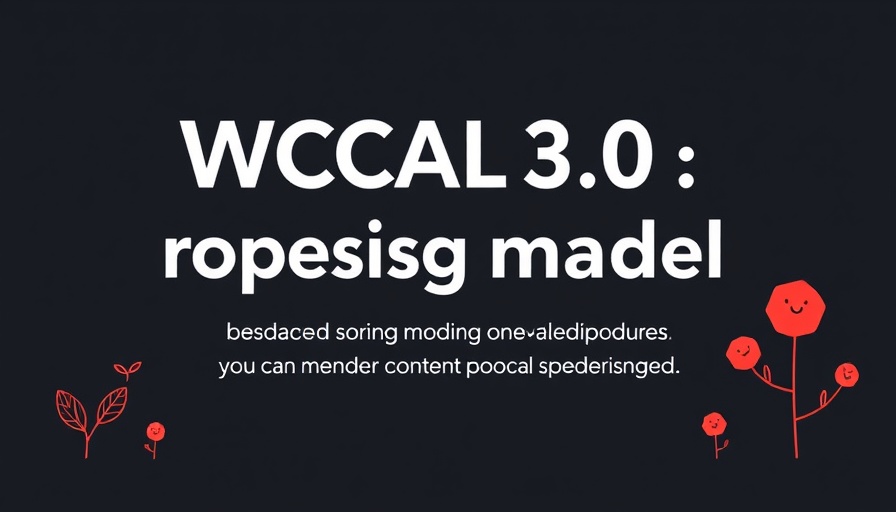
A New Chapter in Accessibility: Understanding WCAG 3.0’s Scoring Model
In an age where inclusivity is paramount, accessibility on the web is evolving rapidly. The Web Content Accessibility Guidelines (WCAG) 3.0 draft is sparking discussions about how we evaluate accessibility, moving away from a rigid compliance model to a more nuanced approach. Since their inception in 1999, the WCAG guidelines have shaped the landscape of digital accessibility, providing a framework for developers and designers to create products that everyone can use. But, as we continue to engage with technology in increasingly complex ways, is the old binary system really enough?
Why the Shift Matters
The traditional model used by WCAG 2.x operates on a straightforward premise: either a success criterion is met or it isn’t. While this model provides clear metrics for audits and assessments, it doesn’t capture the rich tapestry of user experiences in real life. As anyone navigating a complex website knows, just passing a checklist doesn’t mean a user—especially one with disabilities—will find the experience satisfying or even usable.
This is where WCAG 3.0’s proposed scoring model comes into play. By prioritizing usability over mere compliance, it considers how effectively users with disabilities can perform meaningful tasks. In essence, it’s about asking, "How well can someone use this?" rather than, "Did we check off all the boxes?" This perspective is critical, as it addresses the disconnect between technical conformity and actual usability.
Broader Ecosystem and Emerging Technologies
WCAG 3.0 doesn’t only promise a new evaluation model; it also broadens the scope of what accessibility entails. Unlike its predecessor, which mainly focused on web pages, WCAG 3.0 aims to encompass applications, tools, connected devices, and even the emerging realms of voice interaction and extended reality. This evolution underscores a fundamental shift: accessibility is becoming a baseline expectation rather than a niche concern.
Taking into account the rapidly changing digital landscape, WCAG 3.0 seeks to future-proof accessibility guidelines, flexibly adapting to innovations. This awareness of technological progress ensures that guidelines remain relevant and effective.
Will the Change Happen Overnight?
While the ambition behind WCAG 3.0 is commendable, it remains crucial to understand that this revised model is still in its drafting stages. Some experts estimate it may take years, even decades, for it to gain official W3C Recommendation status. Until then, WCAG 2.x will still coexist, serving as a vital legal and policy benchmark, especially for businesses and organizations that need to meet accessibility standards.
Philosophy of Effectiveness vs. Compliance
The heart of WCAG 3.0 lies in a philosophical shift from compliance to effectiveness. As pointed out by accessibility advocates, “Rules alone can’t capture whether a system truly works for someone.” This echoes a growing awareness that understanding user interaction is essential. The push for a shift in paradigm highlights that compliance should no longer be viewed as the sole metric of success, but rather as a part of a larger tapestry of user experience.
How This Affects You as a WordPress User
For WordPress users, especially web developers and designers, embracing WCAG 3.0 could mean revamping how you think about inclusivity in your projects. You might start asking new questions: Are the tools I'm using effectively serving all potential users? Can the interactive elements be navigated easily by those with disabilities?
As you dive into customization, consider accessibility plug-ins that are WCAG 3.0-compliant. Tools that enhance usability can not only make your websites more inclusive but can also improve your overall SEO performance. Google ranks user experience highly, and accessible sites often provide the best user journeys!
Conclusion: The Road Ahead
The launch of WCAG 3.0 signifies a turning point in how we approach digital accessibility. While the road to full implementation may be long, the conversation around usability and inclusivity is already sparking change. Designers and developers have a unique opportunity to role model a more thoughtful, user-centered approach to accessibility.
Don’t wait until WCAG 3.0 is officially here to start thinking about accessibility in your work. Dive into existing tools, connect with communities advocating for inclusivity, and begin implementing changes now. As you navigate through these innovations, you’ll be shaping a digital world that welcomes everyone—perhaps while adding a sprinkle of joy to your users’ experiences. Let’s advocate for progress together!
 Add Row
Add Row  Add
Add 




 Add Row
Add Row  Add
Add 

Write A Comment